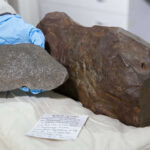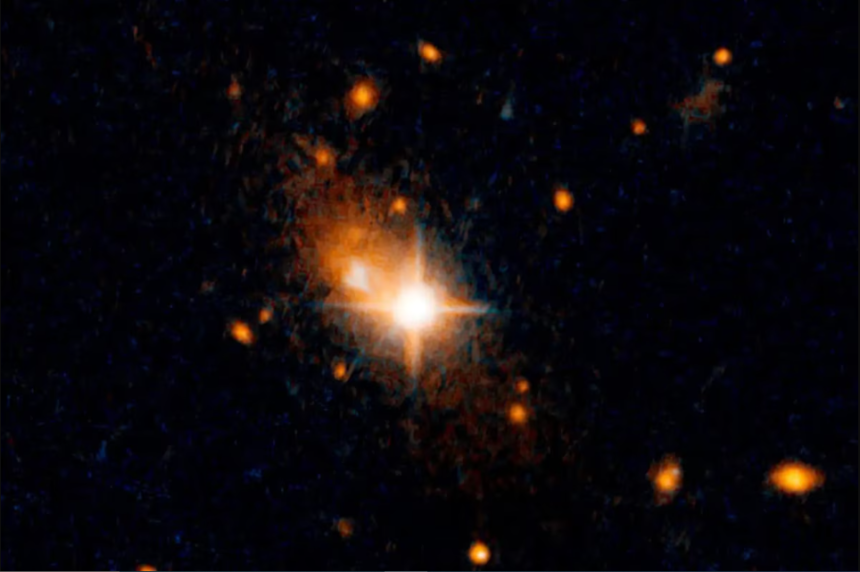A rare cosmic event has captured the attention of the scientific community: the possible collision and subsequent ejection of a supermassive black hole (SMBH). This phenomenon, observed in the galaxy 3C 186, located about 8 billion light years from Earth, could help us with a long-standing theoretical enigma, known as the “last parsec problem.”
According to New Scientist, this black hole is moving at more than 1,000 kilometers per second, the fastest speed ever documented for an object of this type.
The last parsec problem states that mergers between supermassive black holes could stop just before completion due to difficulties in losing enough energy in the final stages of their interaction. However, this recent discovery seems to challenge these predictions.
The study published on the Cornell University website explained that the event offers “direct evidence” of how these objects can merge and be ejected by “a colossal gravitational kick,” a phenomenon generated by the emission of gravitational waves during the collision.
The foundations of research: telescopes and spectroscopic analysis
The research team, led by Marco Chiaberge of Johns Hopkins University, used the Very Large Telescope(VLT) in Chile, Subaru in Hawaii and Hubble to reach these conclusions.
During the first observations of 3C 186, astronomers discovered that the quasar – the powerful light generated by the gravitational activity of the black hole at the center of the galaxy – was conspicuously out of place. This quasar was located about 33,000 light-years from the galactic center, a distance that indicated an “ejection caused by an unknown event, possibly a merger.”
Chiaberge and his team then took a closer look at the light emitted by the accretion disk surrounding the black hole. They identified a marked blue shift, a signal generated by the extreme speed at which the black hole is moving toward the observer.
“ The gas in the surrounding region showed less sign of blueshift, implying that the black hole is outpacing its host galaxy,” the observations reported by New Scientist said.
Analysis of the gaseous emission determined a speed of 1,310 kilometers per second, which confirms the massive acceleration of the black hole. The study stressed: “This can only be explained by a colossal ‘gravitational kick’ or a superkick generated by gravitational waves.”
The role of gravitational waves: an invisible force at work
The merger and subsequent motion of this black hole provides further validation of Einstein’s theory of relativity, which predicts that collisions of these cosmic giants generate ripples in the fabric of space-time. The team used numerical relativity simulations to model the system and explained that these gravitational waves propagated in one direction, while the black hole was “recoiled” in the opposite direction.
The relevance of gravitational waves has been confirmed in other recent investigations, such as those carried out by the Pulsar Timing Arrays, which identified gravitational waves at extremely low frequencies. While these cannot be directly observed in events such as 3C 186, future studies could deepen the understanding of these dynamics through proposed space observatories such as LISA.
Alessia Gualandris from the University of Surrey told New Scientist that while the data is “compelling evidence for a black hole recoil,” there is never absolute certainty in astrophysics. “The recoil hypothesis holds strong ground,” she said. However, not all experts share the same enthusiasm. Luke Zoltan Kelley from the University of California, Berkeley, warned that “active galactic nuclei (AGN) do not always behave in a predictable way,” and that “much more detailed physical modelling is required to confirm this scenario.”
Why is 3C 186 so crucial to science?
With an estimated mass of one billion times that of our Sun, the black hole in 3C 186 is thought to have played a key role in the development of the galactic core that hosts it. The latter is defined as an extremely bright quasar, a reflection of the violent processes of gravitational accretion.
Based on recent studies, the merger that displaced this black hole is estimated to have occurred approximately 56 million years ago. According to the Cornell University report: “The black hole remains surrounded by a perforated accretion disk that slowly reorganized following the impact event.” In addition, the quasar has an estimated remaining lifespan of about 33 million years, making it a suitable candidate for further study.
The researchers note that 3C 186 may not be a unique case, and that many similar binary systems are still waiting to be detected. In the meantime, this finding solidifies the role of gravitational waves and general relativity simulations as indispensable tools for future research.





